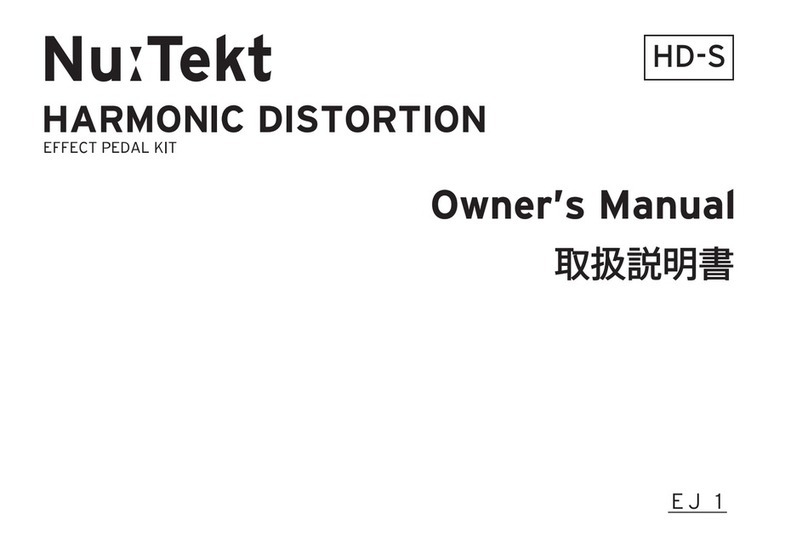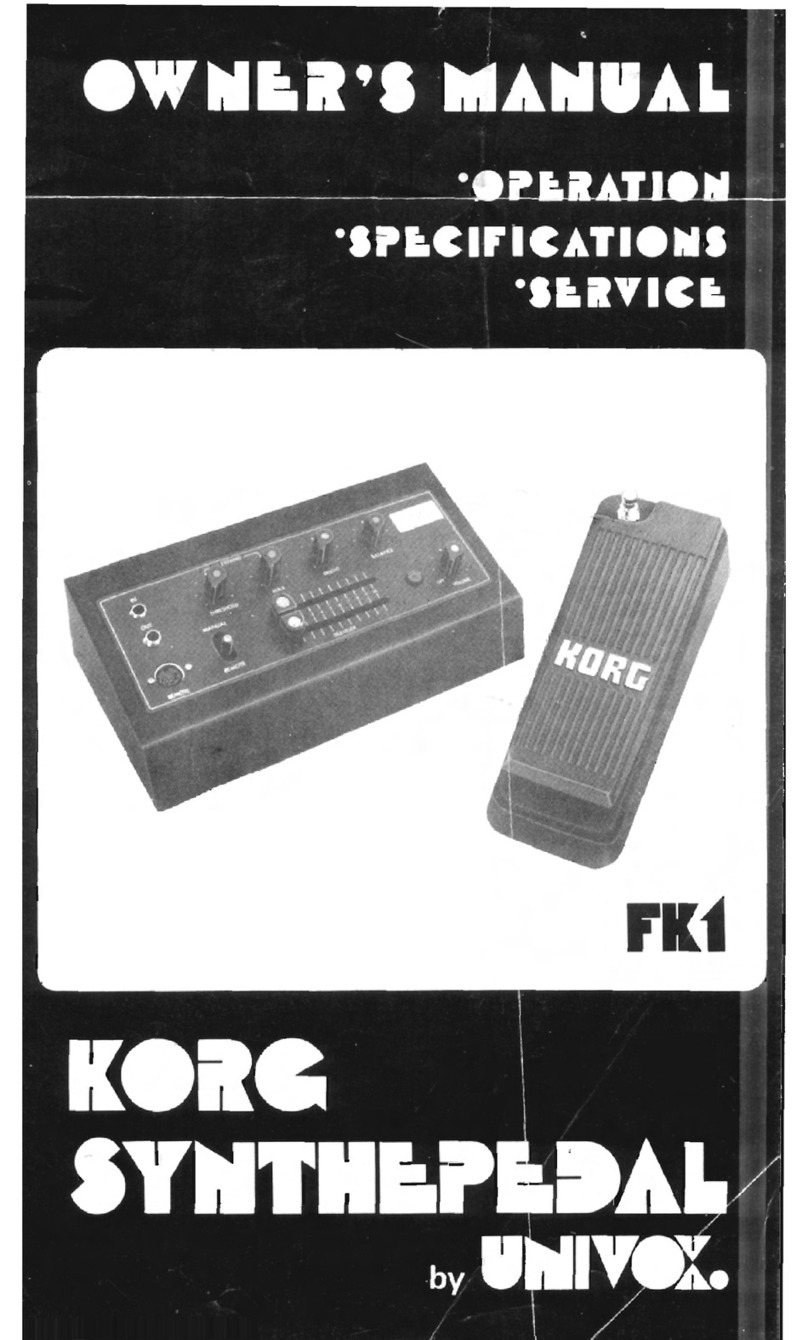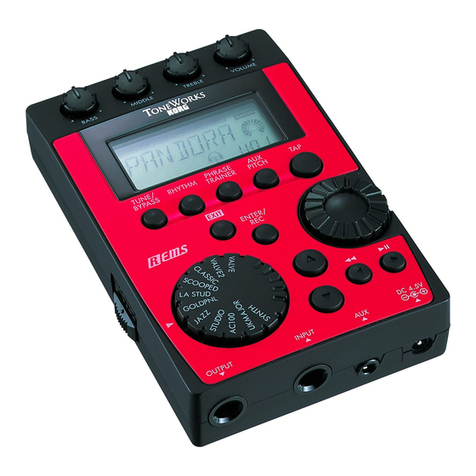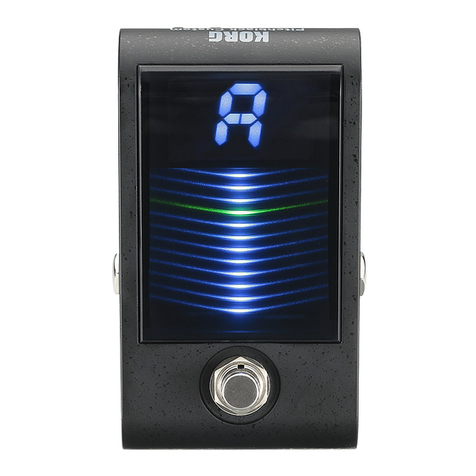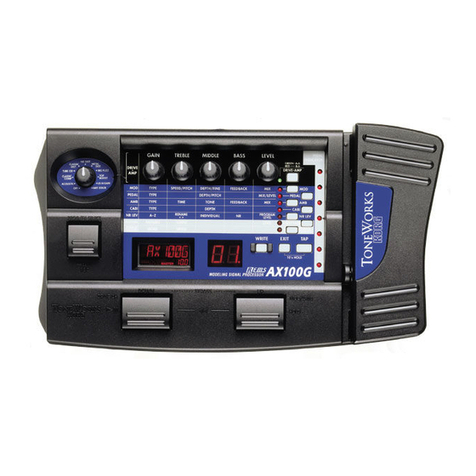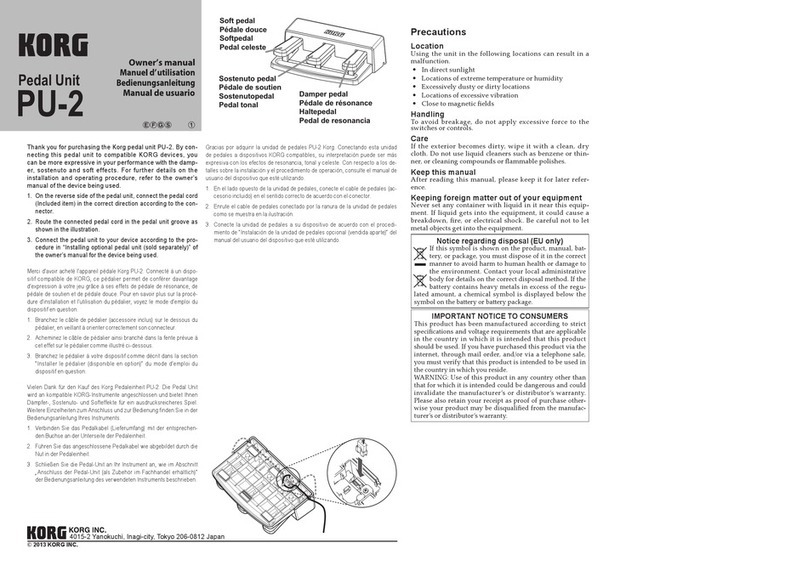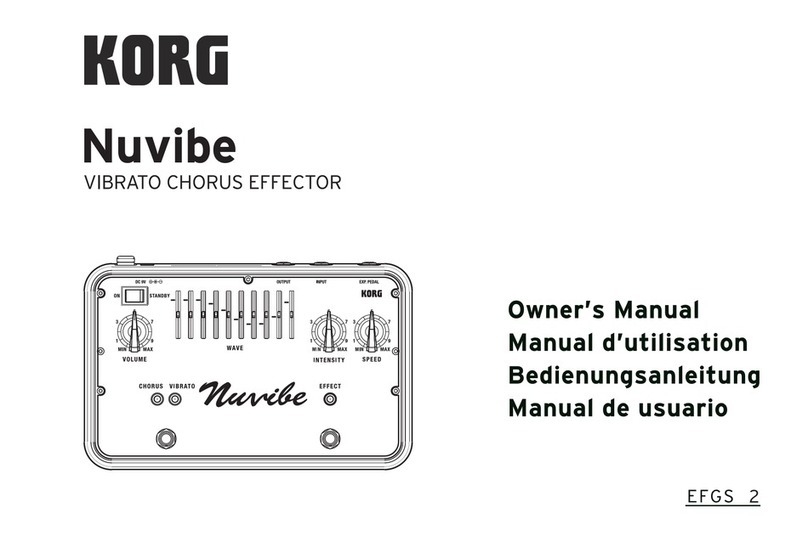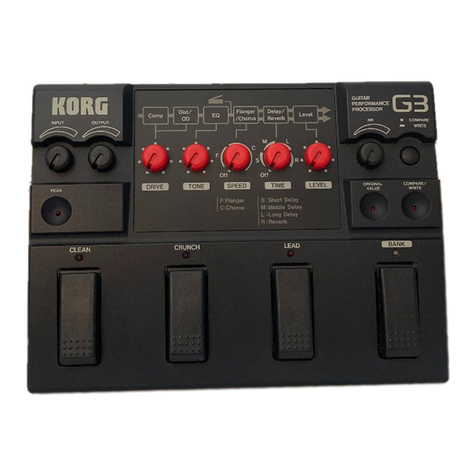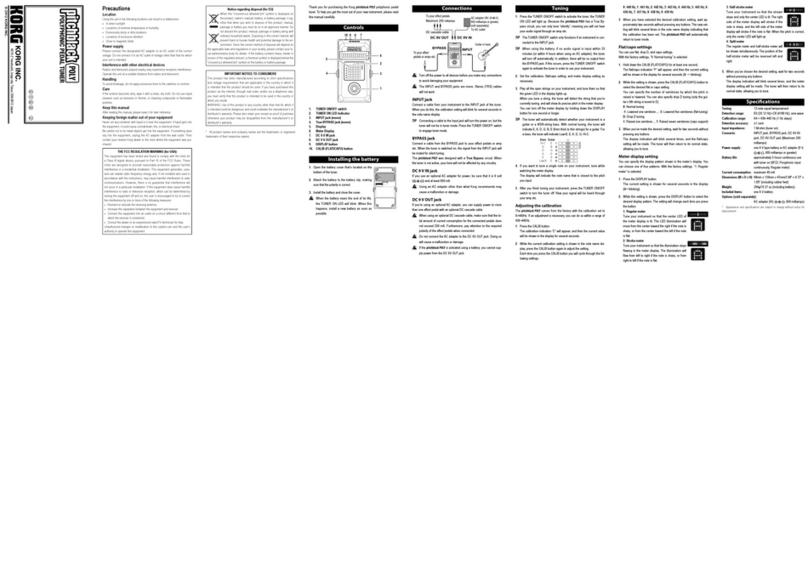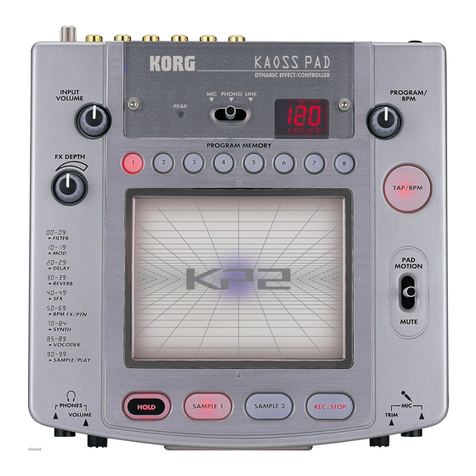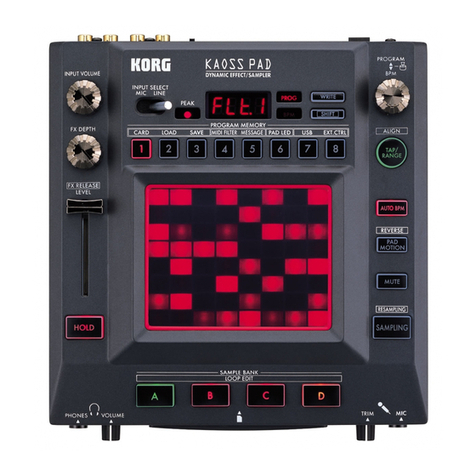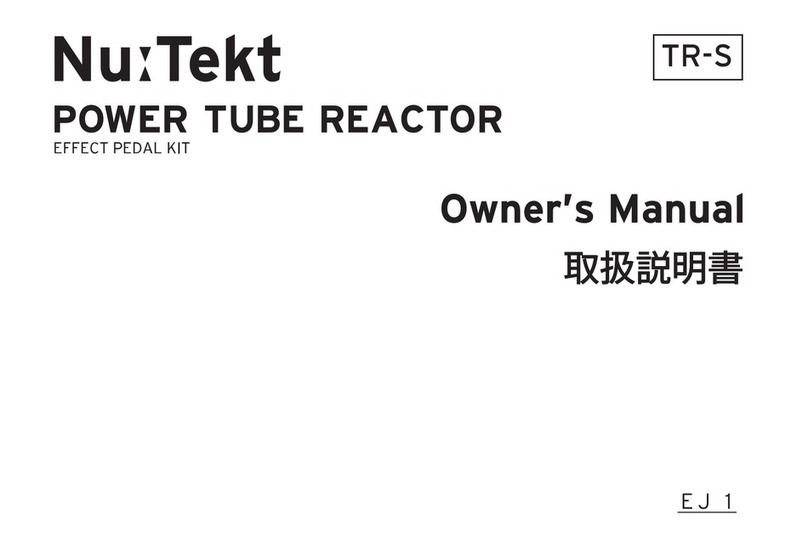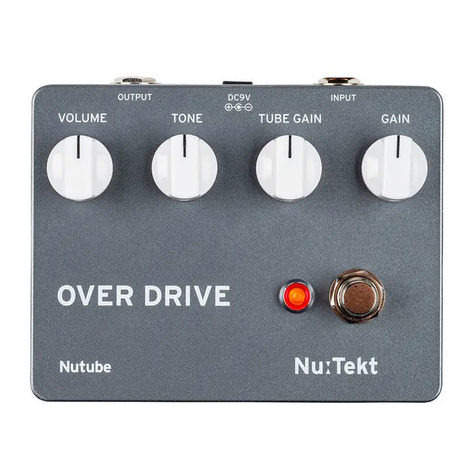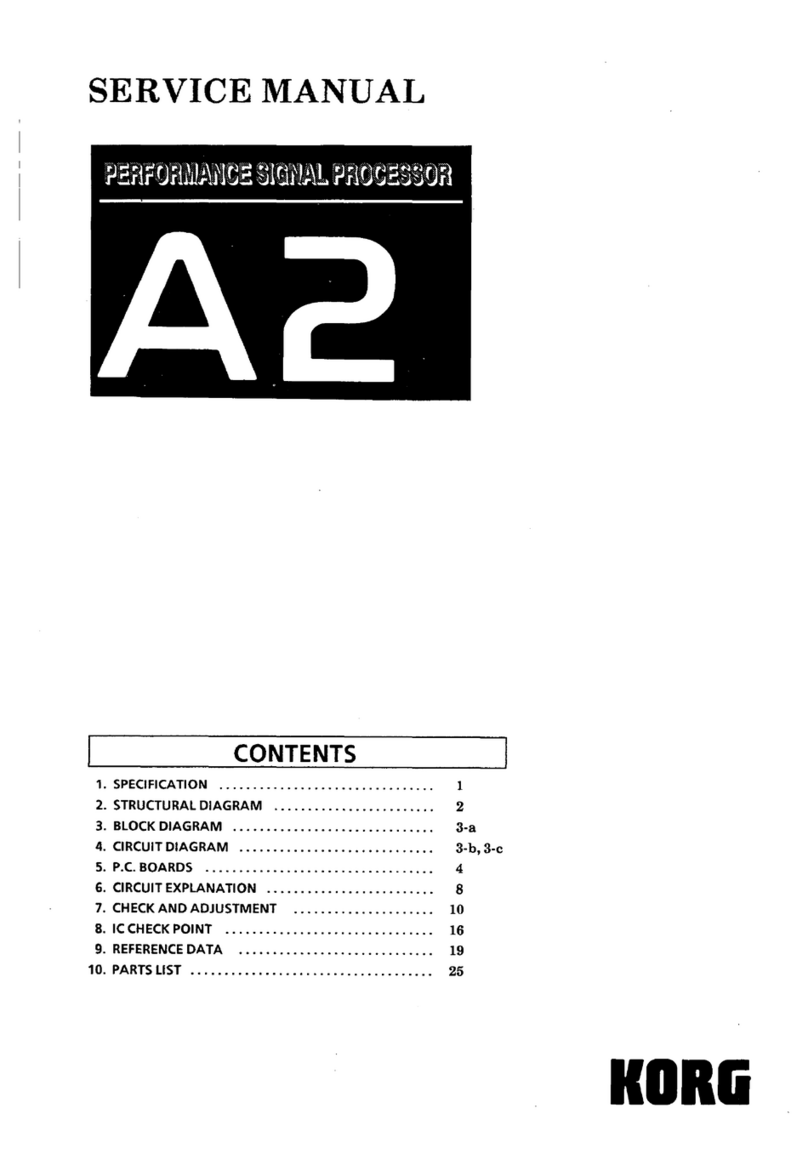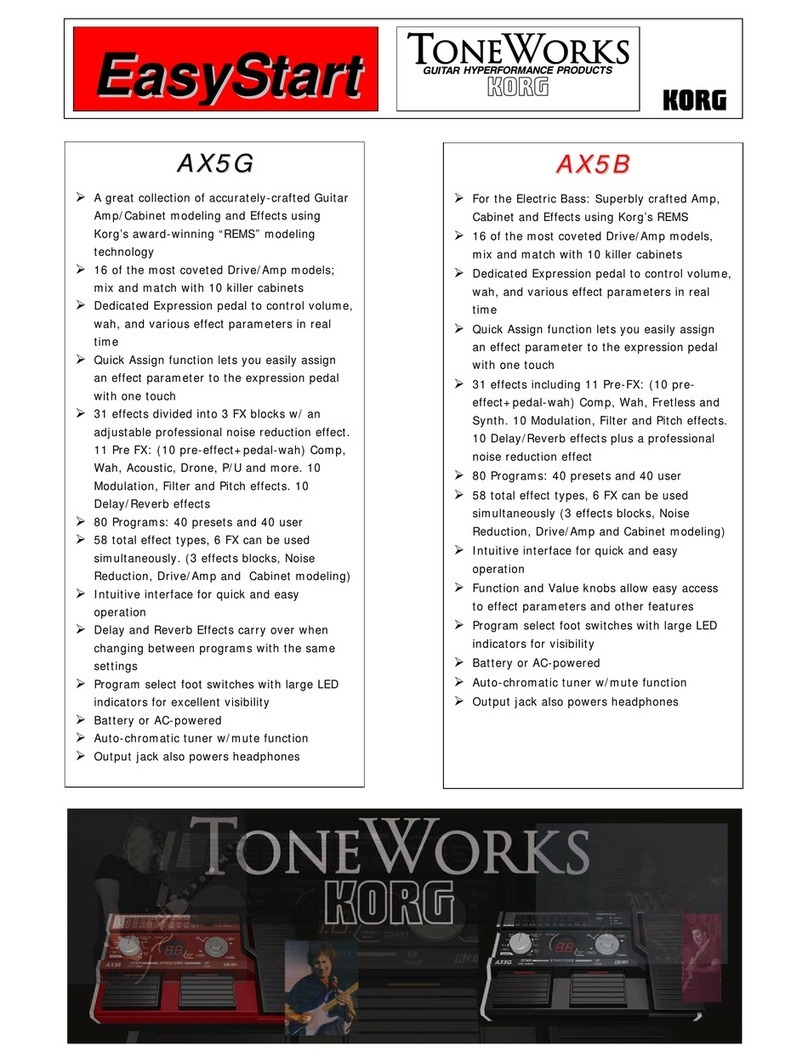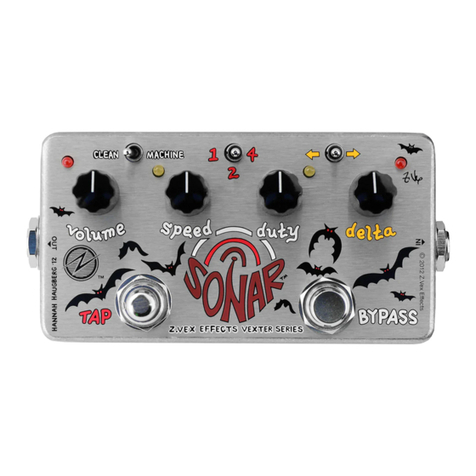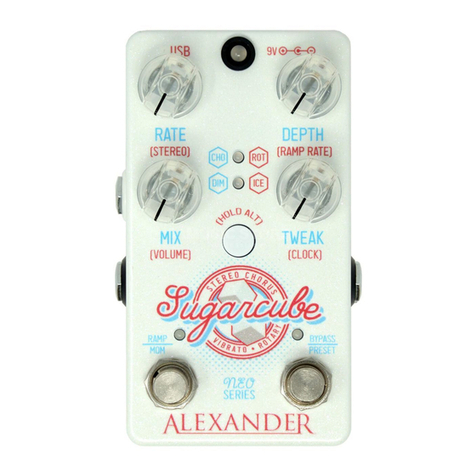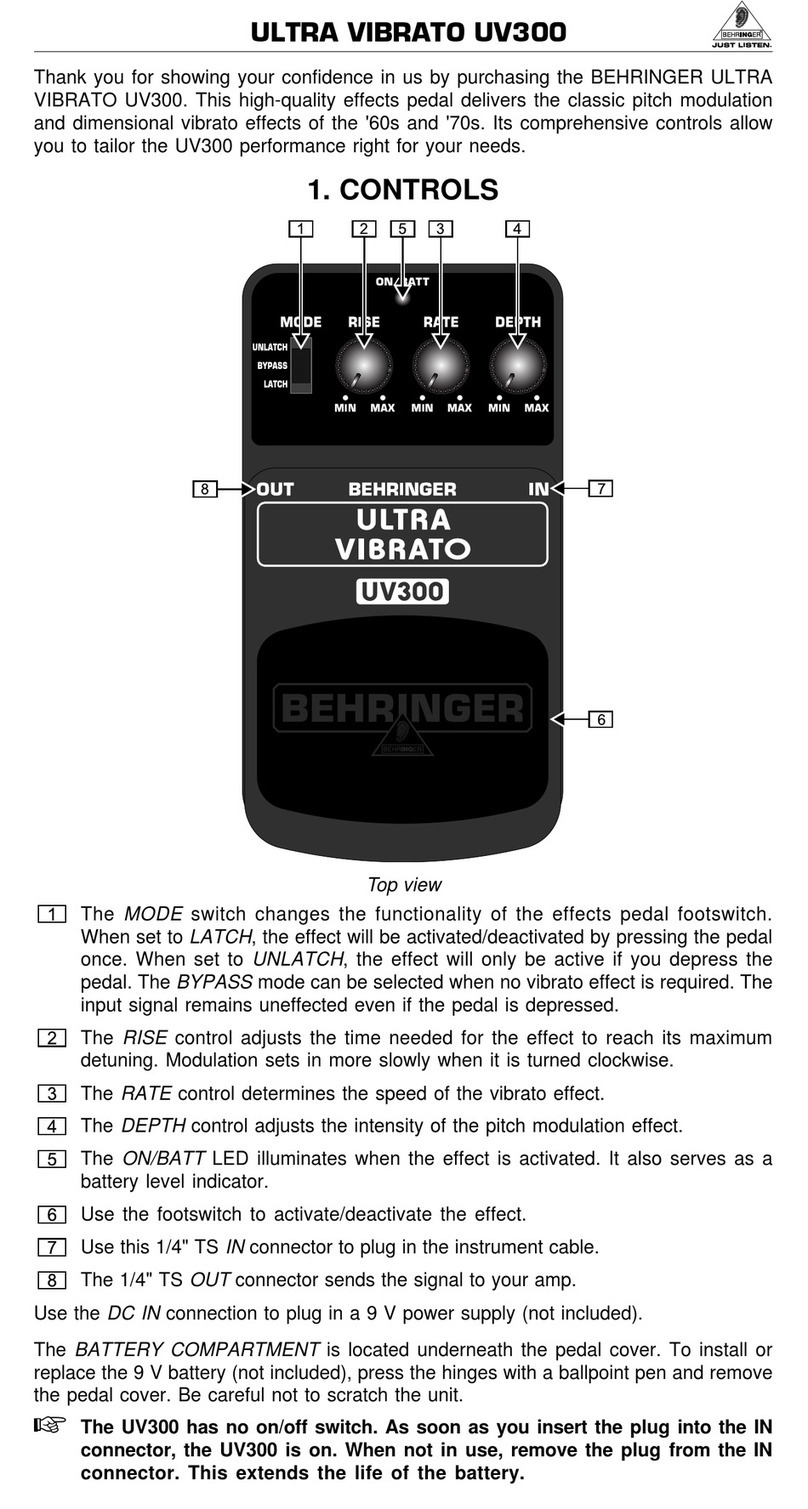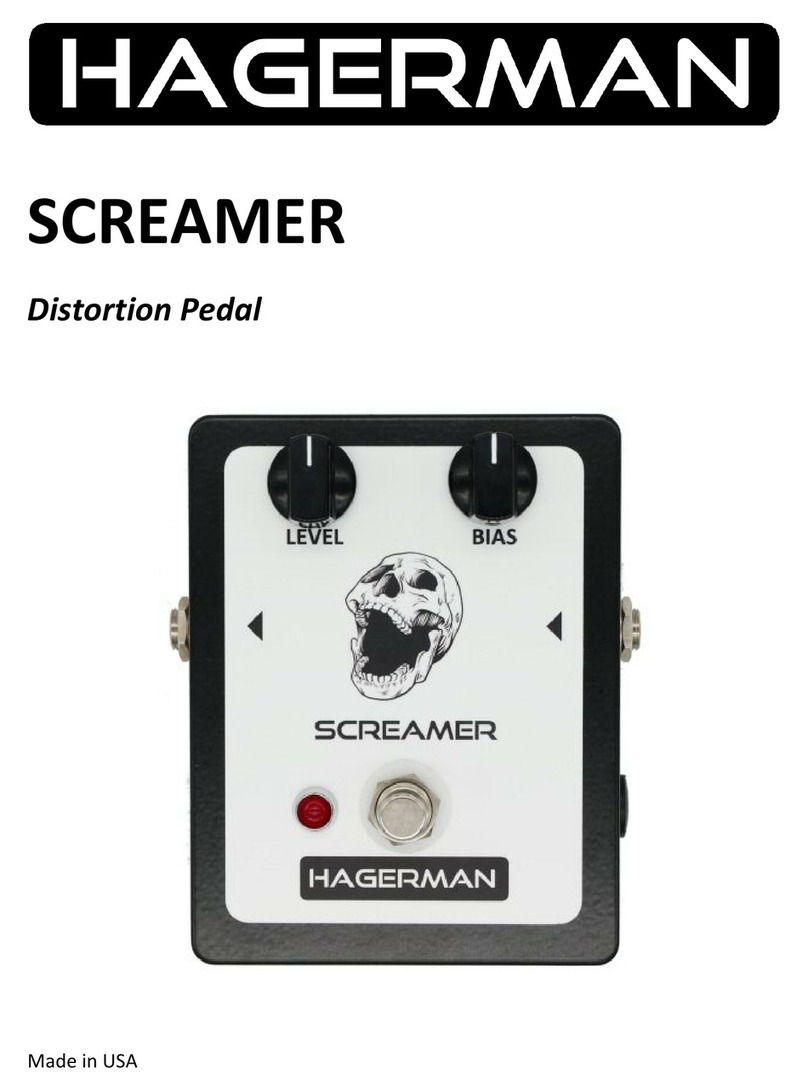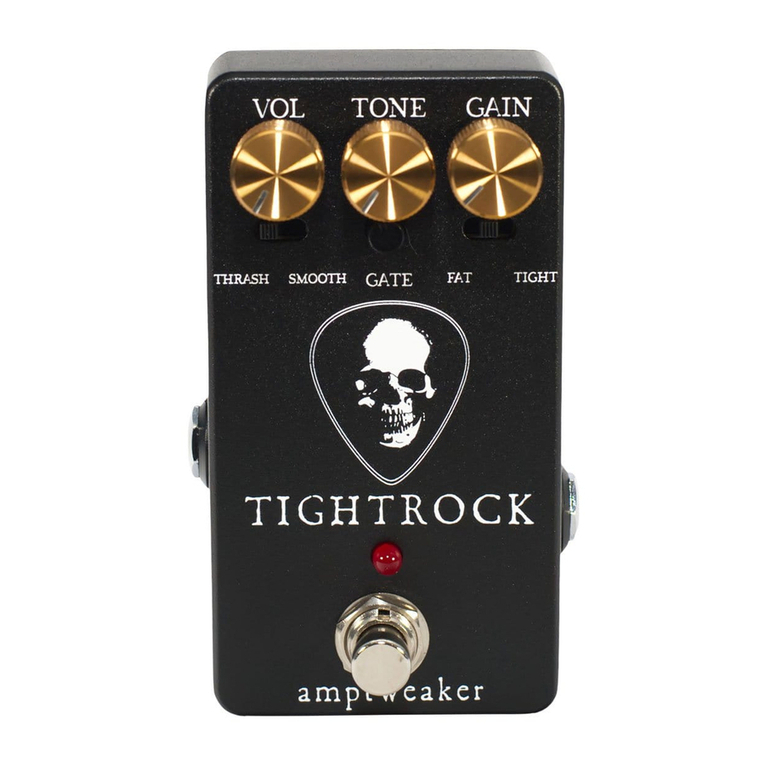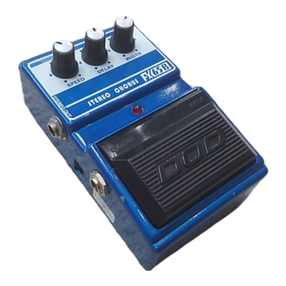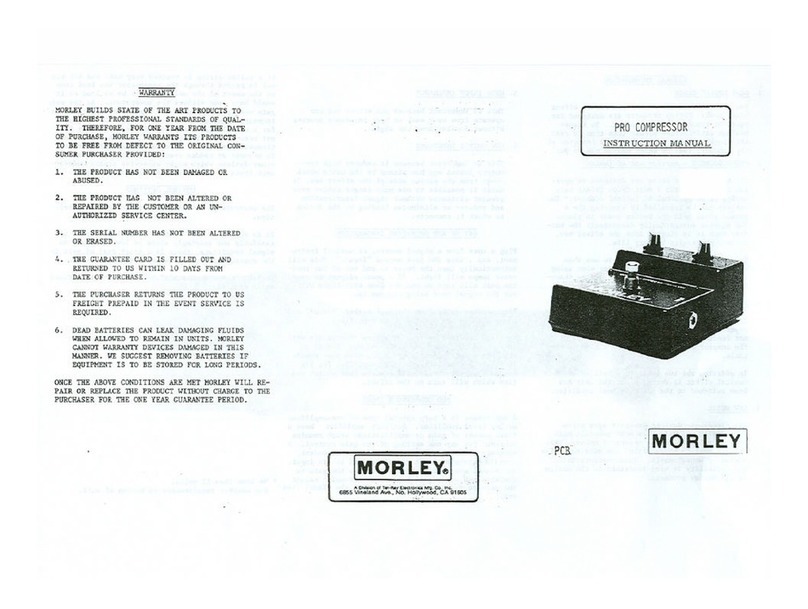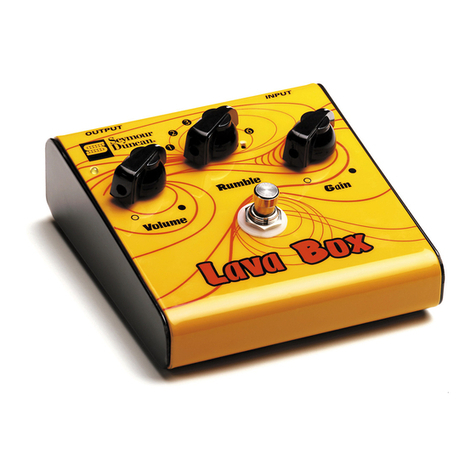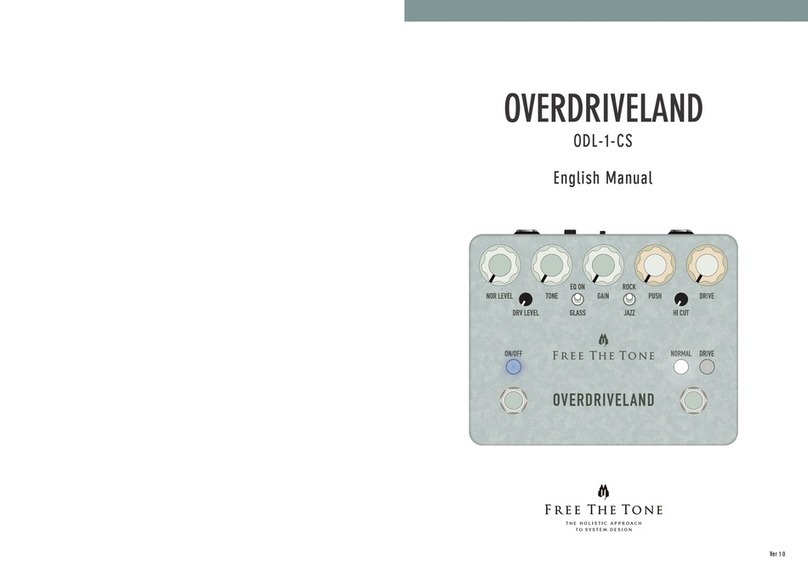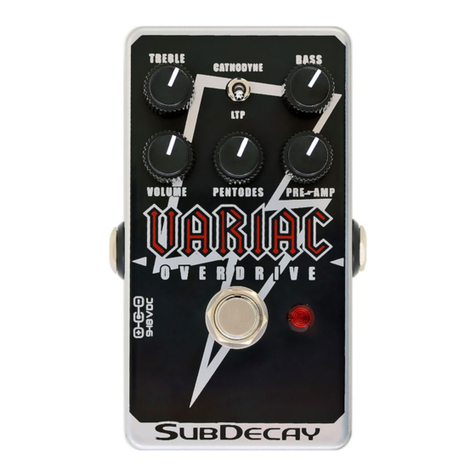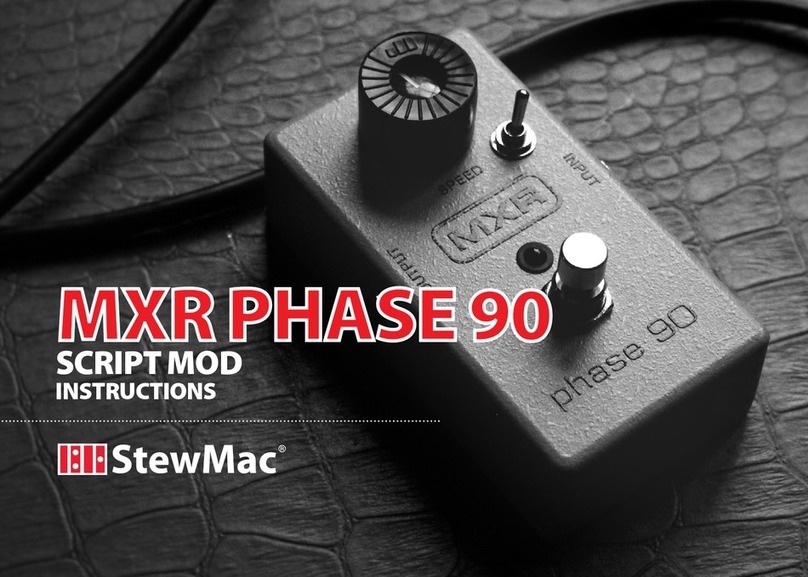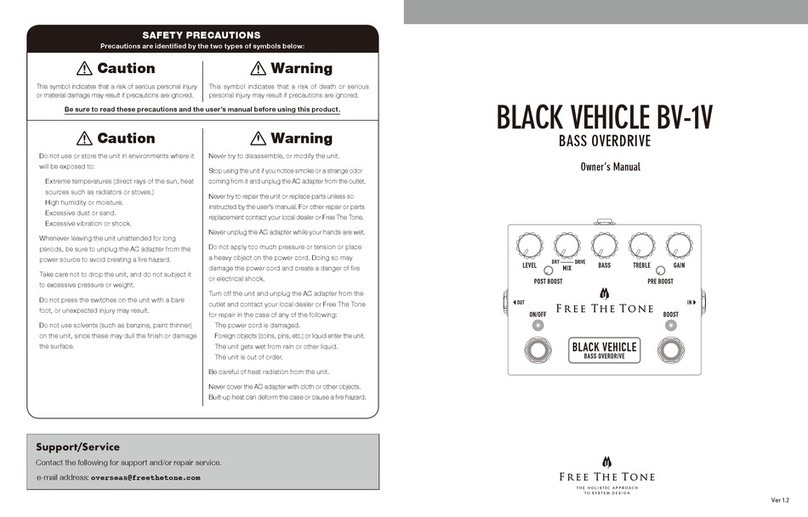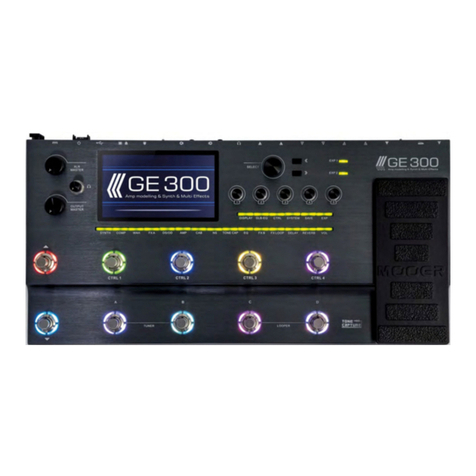Korg Toneworks AX1G User manual

E F D J 3

2
To ensure long, trouble-free operation, please read this manual carefully.
Precautions
Location
Using the unit in the following locations can result in a malfunction.
• In direct sunlight
• Locations of extreme temperature or humidity
• Excessively dusty or dirty locations
• Locations of excessive vibration
Power supply
Please connect the designated AC adaptor to an AC outlet of the correct voltage.Do not connect it to an AC outlet of voltage
other than that for which your unit is intended.
Interference with other electrical devices
This product contains a microcomputer.Radios and televisions placed nearby may experience reception interference. Operate
this unit at a suitable distance from radios and televisions.
Handling
To avoid breakage, do not apply excessive force to the switches or controls.
Care
If the exterior becomes dirty, wipe it with a clean, dry cloth. Do not use liquid cleaners such as benzene or thinner, or cleaning
compounds or flammable polishes.
Keep this manual
After reading this manual, please keep it for later reference.
Keeping foreign matter out of your equipment
• Never set any container with liquid in it near this equipment.If liquid gets into the equipment, it could cause a breakdown, fire,
or electrical shock.
• Be careful not to let metal objects get into the equipment.If something does slip into the equipment, unplug the AC adaptor
from the wall outlet.Then contact your nearest Korg dealer or the store where the equipment was purchased.
Précautions à prendre
Emplacement
L’utilisation de l’appareil dans les endroits suivants risquerait d’être la cause d’un mauvais fonctionnement:
• Sous les rayons directs du soleil
• Dans des endroits de températures extrêmes ou d’une humidité excessive.
• Dans des endroits excessivement sales ou poussiéreux.
• Dans des lieux sujets à des vibrations excessives.
Alimentation DC9V
Veuillez raccorder l’adaptateur secteur fourni à une prise de courant fournissant la tension adéquate. Ne jamais le raccorder à
une prise d’un autre voltage que celui prévu pour l’appareil.
Interférences avec d’autres appareils électriques
Cet instrument contient un micro-ordinateur. Les postes de radio et de télévision situés à proximité peuvent par conséquent
souffrir d’interférences à la réception. Veuillez dès lors faire fonctionner cet appareil à une distance raisonnable de postes de
radio et de télévision.
CE mark for European Harmonized Standards
CE mark which is attached to our company’s products of AC mains operated apparatus until December 31, 1996 means it conforms to EMC
Directive (89/336/EEC) and CE mark Directive (93/68/EEC).And, CE mark which is attached after January 1, 1997 means it conforms to EMC
Directive (89/336/EEC), CE mark Directive (93/68/EEC) and Low Voltage Directive (73/23/EEC).
Also, CE mark which is attached to our company’s products of Battery operated apparatus means it conforms to EMC Directive (89/336/EEC)
and CE mark Directive (93/68/EEC).
THE FCC REGULATION WARNING
This equipment has been tested and found to comply with the limits for a Class B digital device, pursuant to Part 15 of the FCC Rules.These
limits are designed to provide reasonable protection against harmful interference in a residential installation.This equipment generates, uses,
and can radiate radio frequency energy and, if not installed and used in accordance with the instructions, may cause harmful interference to
radio communications. However, there is no guarantee that interference will not occur in a particular installation. If this equipment does cause
harmful interference to radio or television reception, which can be determined by turning the equipment off and on, the user is encouraged to
try to correct the interference by one or more of the following measures:
• Reorient or relocate the receiving antenna.
• Increase the separation between the equipment and receiver.
• Connect the equipment into an outlet on a circuit different from that to which the receiver is connected.
• Consult the dealer or an experienced radio/TV technician for help.
Unauthorized changes or modification to this system can void the user’s authority to operate this equipment.

3
Um einen langfristigen, einwandfreien Betrieb zu gewährleisten, lesen Sie bitte diese Bedienungsanleitung
sorgfältig durch.
Vorsichtsmaßnahmen
Aufstellung
Betreiben Sie das Gerät nicht in folgenden Umgebungen, da dies zu Fehlfunktionen führen könnte:
• in direktem Sonnenlicht
• bei extremerTemperatur oder Luftfeuchtigkeit
• in extrem staubigen oder schmutzigen Umgebungen
• unter dem Einfluß starker Vibrationen
Stromversorgung
Schließen Sie den mitgelieferten Wechselstromadapter bitte nur an eine Steckdose mit korrekter Netzspannung an.Schließen
Sie den Adapter nicht an eine Netzsteckdose an, die eine Spannung liefert, für die Ihr Gerät nicht vorgesehen ist.
Interferenzen bei anderen Elektrogeräten
Dieses Produkt ist mit einem Mikrocomputer ausgerüstet.Bei der Aufstellung in direkter Nähe von Rundfunk-und Fernsehgeräten
kann deren Empfang durch Interferenzen gestört werden.Betreiben Sie dieses Gerät deshalb in ausreichender Entfernung von
Rundfunk- und Fernsehempfängern.
Handhabung
Bedienen Sie die Schalter und Regler nicht mit übermäßiger Kraft, um Beschädigungen zu vermeiden.
Reinigung
Wenn das Gehäuse verschmutzt ist, reinigen Sie es mit einem trockenen, weichen Tuch. Verwenden Sie keine flüssigen
Reinigungsmittel, zum Beispiel Leichtbenzin, Verdünner, Lösungsmittel oder brennbare Polituren.
Bedienungsanleitung
Nachdem Sie die Bedienungsanleitung gelesen haben, sollten Sie sie für den späteren Gebrauch gut aufbewahren.
Fremdgegenstände
• Stellen Sie keine Behälter mit Flüssigkeit in die Nähe dieses Geräts.Wenn Flüssigkeiten in das Gerät gelangen, könnte dies einen System-
ausfall, Brand oder Stromschlag zur Folge haben.
• Achten Sie darauf, daß keine Metallgegenstände in das Gerät gelangen. Sollte dies dennoch geschehen, ziehen Sie den Wechselstrom-
adapter aus der Netzsteckdose. Setzen Sie sich anschließend mit dem nächstgelegenen Korg-Fachhändler oder dem Geschäft inVerbin-
dung, in dem Sie das Gerät gekauft haben.
Manipulations
Pour éviter tout dommage, ne jamais exercer une force excessive sur les interrupteurs ou les commandes.
Entretien
Essuyer l’extérieur avec un chiffon propre et sec. Ne jamais utiliser de détergents liquides comme du benzène ou du thinner ni
des composants de nettoyage ou des cires inflammables.
Conserver le manuel
Après avoir lu attentivement le présent manuel, veuillez le conserver pour pouvoir le consulter ultérieurement.
Tenir tout corps étranger à l’écart de l’instrument:
• Ne jamais poser de récipient contenant du liquide à proximité de l’instrument. La pénétration de liquide dans l’instrument
risquerait de provoquer une panne, un incendie ou un court-circuit.
• Veiller à ce qu’aucun objet métallique ne tombe dans l’instrument. Si un corps étranger a pénétré dans l’équipement,
débrancher l’adaptateur de la prise secteur puis contacter le représentant Korg le plus proche ou le magasin où l’équipe-
ment a été acheté.
* CE-Marke der EG-Norm
Die CE-Marke auf unseren netzgespeisten Geräten deutet auf deren Übereinstimmung mit den EMC- und CE-Richtilinien
der EG (respektive 89/336/EWG und 93/68/EWG) hin.Diese Abzeichen ist bis zum 3. Dezember 1996 gültig.
Die CE-Marke ab 1. Januar 1997 deutet auf Übereinstimmung mit den EMC-, CE- und Niederspannungsstrom-Richtilinien
der EG (respektive 89/336/EWG, 93/68/EWG und 93/68/EWG) hin.
Die CE-Marke auf unseren batteriegespeisten Geräten deutet auf deren Übereinstimmung mit den EMC- und CE-Richtilinien
der EG (respektive 89/336/EWG und 93/68/EWG) hin.
* Marque CE de conformité aux normes de sécurité européennes
La marque CE attachée à nos produits alimentés par secteur indique que ces produits sont conformes à la directive EMC (89/336/
CEE) ainsi qu'à la directive relative à la marque CE (93/68/CEE).Cette marque est valable jusqu'au 31 décembre 1996.
La marque CE attachée après le 1 janvier 1997 indique que ces produits sont conformes à la directive EMC (89/336/CEE), à la
directive relative à la marque CE (93/68/CEE) ainsi qu'à la directive relative au courant de guitare tension (73/23/CEE).
Enfin, la marque CE attachée à nos produits alimentés par batterie indique que ces produits sont conformes à la directive EMC (89/
336/CEE) ainsi qu'à la directive relative à la marque CE (93/68/EEC).

4
以下の指示を守ってください
警告
●本製品を使用する前に、以下の指示をよく読んでください。
●ACアダプターを使用する場合は、必ずAC100Vの電源コンセ
ントにACアダプターを差し込んでください。
●次のような場合には直ちに電源を切り、ACアダプター使用時は
コンセントから抜きます。そして、コルグ営業所またはお買い上げ
になった販売店に修理を依頼してください。
○ ACアダプターの電源コードやプラグが破損したとき
○異物が内部に入ったり、液体がこぼれたとき
○製品が( 雨などで)濡れたとき
○製品に異常や故障が生じたとき
●次のような場所での使用や保存はしないでください。
○温度が極端に高い場所(直射日光のあたる場所、暖房機器
の近く、発熱する機器の上など)
○水気の近く(風呂場、洗面台、濡れた床など)や湿度の高い
場所
○ホコリの多い場所
●修理/部品の交換などで、取扱説明書に書かれている以外の
ことは、絶対にしないでください。必ず最寄りのコルグ営業所また
はコルグ営業技術課に相談してください。
●ACアダプターのコードを無 理 に曲げたり、上に重いものを乗せ
たりしないでください。コードに傷がつき危険です。
●本製品をヘッドホン、アンプ、スピーカーと組み合わせて使用した
場合、設定によっては永久的な難聴になる程度の音量になりま
す。大音量や不快な程度の音量で長時間使用しないでくださ
い。万一、聴力低下や耳鳴りを感じたら、専門の医師に相談して
ください 。
●本製品に、異物(燃えやすいもの、硬貨、針金など)や液体(水
やジュースなど)を絶対にいれないでください。
●本製品およびACアダプターを分解したり、改造したりしないでく
ださい。
注意
●本製品は正常な通気が妨げられることのない所に設置して、使
用してください。
●本製品はマイクロコンピュータを使用した機器です。このため
他の電気機器を接近して同時にご使用になりますと、それらに雑
音が入ることがあります。逆に他の電気機器から本製品が雑音
を受けて誤動作する場合があります。
●ACアダプターをご使用になる場合は、必ず指定のものをご使
用ください。他のアダプターをご使用になりますと故障の原因と
なります。また、使用後はACアダプターをコンセントから抜いてく
ださい。
●ACアダプターは他の電気機器の電源コードといっしょにタコ足
配線することは危険です。
●長期間使用しない場合は、電池の液漏れを防ぐために電池を
抜いておいてください。
●スイッチやツマミに必要以上の力を加えますと故障の原因となり
ますので注意してください。
●外装のお手入れは、必ず乾いた柔らかい布で軽く拭いてくださ
い。ベンジンやシンナー系の液体は絶対にご使用にならないで
ください 。(コンパウンド質、強燃性のポリッシャーも不 可 )。
●製品をお買い上げいただいた日より一年間は、保証期間となり、
修理は無償となりますが、保証書に購入店での手続きがない場
合は無効となります。保証書は必ずお求めになった販売店で所
定の手続きを行った後、大 切に 保 管してください 。
●今後の参照のために、この取扱説明書はお読みになった後も大
切に保管してください。
●ACアダプターをコンセントから抜くときは、絶対にコードを引っぱ
らないでください 。故障の原因となります。
安全上のご注意
火災・感電・人身傷害の危険を防止するには

Table of contents Table des matière
5
NOTICE D’
EMPLOI
BEDIENUNGSANLEITUNG
取扱説明書 OWNER’S MANUAL
Appendices Appendices
Anhänge
付録
Table of contents
■Introduction ............................................ 7
1. Main features .............................................. 7
2. Installing the batteries .................................. 7
3. Front and rear panel.................................... 7
●Front panel..........................................................7
●Rear Panel ..........................................................8
●LCD display .........................................................8
4. Making connections ..................................... 9
■Play mode ............................................ 10
1. Let's play the AX1G ................................... 10
●Turn on the power .............................................10
●Adjusting the master level (overall volume) .........10
●Select a program and play.................................10
2. Bypass and mute ....................................... 10
●Bypass ..............................................................10
●Mute .................................................................10
3. Tuner......................................................... 11
●Tuning your guitar .............................................11
●Changing the calibration ....................................11
4. Metronome................................................ 11
●Start the metronome, and adjust the tempo and out-
put level (volume) ..............................................11
5. Using the expression pedal ........................ 12
●Play using the expression pedal .........................12
●Using the Sample & Play effect ...........................12
●Calibrating (adjusting) the expression pedal .......13
■Edit mode............................................. 14
1. Selecting the parameter to edit ................... 14
2. Editing effect parameters ........................... 14
●DRIVE................................................................14
●TONE ................................................................14
●MOD .................................................................14
●PEDAL ...............................................................15
●AMB .................................................................15
●CR ....................................................................15
●NR ....................................................................15
3. Editing other parameters............................ 15
●LEVEL ................................................................15
●RENAME ...........................................................15
●WRITE ...............................................................16
4. Restoring the preset programs (factory setting
programs) ................................................. 16
■Appendices .......................................... 50
1. Effect Parameter list ................................... 50
2. Preset program parameter list .................... 55
3. Troubleshooting ......................................... 55
4. Specifications ............................................ 58
■ Introduction ............................................... 17
1. Caractéristiques principales......................... 17
2. Mise en place des piles ................................. 17
3. Panneaux avant et arrière ............................. 17
●Panneau avant ......................................................... 17
●Panneau arrière ....................................................... 18
●Affichage LCD ........................................................ 18
4. Raccordements ................................................. 19
■Mode de jeu ............................................... 20
1. Comme nt jouer sur le AX1G ....................... 20
● Mettre l’appareil sous tension ............................. 20
●Réglage du niveau principal (niveau global) .... 20
●Sélectionner un programme et jouer .................. 20
2. Contournement et suppression du son ...... 20
●Contournemen ........................................................ 20
●Assourdissement (Mute) ...................................... 21
3. Accordeur ......................................................... 21
●Accordage de la guitare ......................................... 21
●Modification du calibrage .................................... 21
4. Métronome ...................................................... 21
●Démarrer le métronome et régler le tempo ainsi
que le niveau de sortie (le volume) ..................... 21
5. Utilisation de la pédale d’expression ......... 22
●Interprétation en utilisant la pédale d’expression
22
●Utilisation de l’effet Echantillonnage et Jeu
(Sample & Play) ...................................................... 22
●Calibrage (réglage) de la pédale d’expression .. 24
■Mode d’édition (EDIT) ............................ 25
1. Sélection d’un paramètre à éditer ............... 25
2. Edition des paramètres d’effets ................... 25
●DRIVE ....................................................................... 25
●TONE ........................................................................ 25
●MOD ......................................................................... 26
●PEDAL ...................................................................... 26
●AMB .......................................................................... 26
●CR .............................................................................. 26
●NR .............................................................................. 26
3. Edition d’autres paramètres ......................... 27
●LEVEL ....................................................................... 27
●RENAME .................................................................. 27
●WRITE....................................................................... 27
4. Rappel des programmes prédéfinis (program-
mes préenregistrés à l’usine) ....................... 28
■Appendices .......................................... 50
1. Liste des paramètres des effets ................... 50
2. Liste de paramètre des programmers prédéfinis
................................................................. 55
3. Guide de dépannage ................................. 55
4. Spécifications techniques ............................ 58

Inhalt
目次
6
■Einleitung ............................................. 29
1. Hauptfunktionsmerkmale ........................... 29
2. Batterien einbauen ..................................... 29
3. Vorder-und Rückseite ................................. 29
●Vorderseite ........................................................ 29
●Rückseite ...........................................................30
lLC-Display ...........................................................30
4. Anschlüsse herstellen.................................. 31
■Play-Modus .......................................... 32
1. AX1G spielen ............................................ 32
●Gerät einschalten ..............................................32
●Master Level (Gesamtlautstärke) einstellen ..........32
●Programm wählen und spielen ...........................32
2. Bypass und Mute ....................................... 32
●Bypass ..............................................................32
●Mute .................................................................33
3. Tuner......................................................... 33
●Gitarre stimmen ................................................33
●Kalibrierung ändern ..........................................33
4. Metronome................................................ 33
●Starten Sie das Metronom, und stellen Sie das Tempo
und den Ausgangspegel (Lautstärke) ein .............33
5. Einsatz des Expressionpedals ..................... 34
●Spielen und Expressionpedal einsetzen ...............34
●Sample & Play-Effekt einsetzen ..........................34
●Expressionpedal kalibrieren (einstellen) ..............36
■Edit-Modus ........................................... 37
1. Den zu editierenden Parameter wählen ...... 37
2. Effektparameter editieren........................... 37
●DRIVE................................................................37
●TONE ................................................................37
●MOD .................................................................37
●PEDAL ...............................................................38
●AMB .................................................................38
●CR ....................................................................38
●NR ....................................................................38
3. Weitere Parameter editieren....................... 38
●LEVEL ................................................................38
●RENAME ...........................................................39
●WRITE ...............................................................39
4. Preset-Programme (Werksprogramme) wieder-
herstellen .................................................. 39
■Anhänge .............................................. 50
1. Effektparameterliste ................................... 50
2. Parameterliste der Preset-Programme ......... 55
3. Fehlersuche ............................................... 55
4. Technische Daten ....................................... 58
■はじめに ....................................................... 40
1. 主な特長 ............................................................. 40
2. 電池の入れ方 ...................................................... 40
3. 各部の名称とはたらき .......................................... 40
●フロント・パネル ............................................................40
●リア・パネル ..................................................................41
●液晶ディスプレイ ............................................................41
4.接続してみよう .................................................... 42
■プレイ・モード................................................ 43
1. AX1Gを演奏してみましょう................................. 43
●電源をオンにします ........................................................43
lマスター・レベル(全体の音量)を調整します ....................... 43
●プログラムを選んで演奏してみよう ..................................43
2. バイパス、ミュート ............................................... 43
●バイパスにします ...........................................................43
●ミュートにします ............................................................43
3. チューナー .......................................................... 44
●ギターをチューニングします ............................................44
●キャリブレーションを変更します ....................................... 44
4. メトロノーム........................................................44
●メトロノームをスタートして、テンポと出力レベル(音量)
を調節します ....................................................... 44
5. エクスプレッション・ペダルを使ってみましょう......... 45
●エクスプレッション・ペダルを使って演奏します ..................45
●サンプル&プレイ・エフェクトの操作方法 ........................... 45
●エクスプレッション・ペダルの調整(キャリブレーション)について
46
■エディット・モード .......................................... 47
1. エディット・パラメータの選択 ................................ 47
2. エフェクト・パラメータのエディット ........................ 47
●DRIVE .........................................................................47
●TONE ..........................................................................47
●MOD ...........................................................................47
●PEDAL .......................................................................48
●AMB ...........................................................................48
●CR ...............................................................................48
●NR ...............................................................................48
3.その他のパラメータのエディット ............................. 48
●LEVEL ........................................................................48
●RENAME ....................................................................48
●WRITE ........................................................................49
4. プリセット・プログラム(工場出荷時のプログラム)に戻すに
は ...................................................................... 49
■付録 .............................................................50
1. エフェクト・パラメータ・リスト ............................... 50
2.プリセット・プログラム・パラメータ・リスト .............. 55
3. 故障かな?と思ったら ........................................... 55
4. 主な仕様 ............................................................. 58

7
Introduction
Introduction
■Introduction
Thank you for purchasing the ToneWorks AX1G High
Performance Processor.In order to enjoy long and
trouble-free use, please read this owner’s manual and
use the product correctly. Keep this manual in a safe
place for future reference.
1. Main features
●69 types of effect variation are provided, and
a maximum of seven effects can be used si-
multaneously.
● 30 (10 x three banks) user programs are pro-
vided in internal memory.
●The expression pedal lets you control effects
in realtime.
●Thesample&playfunctionletsyourecordaphrase
that you play (up to 1.8 seconds long), and use the
pedal to play it back.
● The IPE (Integrated Parameter Edit) system
makes editing easy, so you don’t have to deal
with large numbers of confusing parameters.
●A metronome is built-in for convenience when
practicing alone.
●The auto chromatic tuner helps you tune when
the unit is bypassed or muted.
●The friendly user interface features a liquid
crystal display.
●LCD backlit by luminous material -easy view-
ing in dark locations without wearing down the
batteries.
2. Installing the batteries
1Lightly press on arrow A of the battery case,
and slide the lid upward in the direction of
the arrow to open the case.
2Insert four AA alkaline batteries (sold sepa-
rately) as shown in the diagram. Be careful
to observe the correct polarity (+ and -) of
the batteries.
3Close the lid of the battery case.
If you will not be using the unit for an extended
period of time, remove the batteries to prevent
them from leaking.
When the battery empty indicator ( symbol)
appears in the LCD, it is time to replace the
batteries. Replace the batteries as soon as
possible.
Batteries and an AC adapter are not included
with this product. They must be purchased
separately.
3. Front and rear panel
●Front panel
12
3
4
5
6
7
89
A
0
B
1DOWN/UP switches
Use these switches to select programs, or to by-
pass or mute the unit.
2Expression pedal
This controls the effect that you selected as the
pedal effect.
3TYPE [√]/[®] keys
In Edit mode, these keys are used to select the
type of effect that you wish to edit.
4VALUE [-]/[+] keys
Use these keys to edit parameters and to turn the
metronome on/off.
5EDIT/EXIT key
Use this key to enter Edit mode and to return to
Play mode.
6BANK SELECT key
Use this key to select banks.
7Pedal indicator
This indicates the on/off status of the pedal effect,
or the recording condition when the sampler effect
is used.
8BANK/TUNER LED
These LEDs indicate the bank of the selected pro-
gram.When the tuner is operating, these LEDs
function as a tuning meter.
9PROGRAM/NOTE display
This indicates the program number.When the unit
is bypassed or muted and the tuner is operating, it
indicates the note name.
0LCD with luminous backlight
Before using the unit in a dark location, expose the
LCD to sunlight or fluorescent light.

8
Introduction
APAGE [√]/[®] keys
In Edit mode or when the metronome is on, these
keys are used to select the parameter that you wish
to modify.
BENTER key
In Edit mode, this key is used to switch the effect
on/off, or to write a program.
●Rear Panel
1
23
4
5
1INPUT jack
If you are using batteries, this jack acts as a power
switch.When a cable is connected, the power will
be turned on.
Before turning the power on or off, be sure to
turn down the volume of any equipment that is
connected.
2Input level switch
Set this switch according to the output of your in-
strument.
H:Suitable for a pickup with a high output level,
such as a humbucking pickup
L: Suitable for a pickup with a low output level,
such as a single coil pickup
3OUTPUT/PHONES jack
4DC9V
The separately sold AC adapter (DC9V )
can be connected here.When this is connected,
the power will be turned on automatically.
5Cable hook
If the separately sold AC adapter is connected,
hook the cable of the AC adapter around this hook
as shown below. When removing the cable from
the hook, do not apply excessive tension to the
cable.
●LCD display
1
2
3
45
6
7
1Effect on/off indicators
These indicate the effects (drive, tone, modulation,
pedal, ambiance) which are turned on.
2Edit mode indicator
3Battery empty indicator
4Cabinet resonator on/off indicator
5Metronome on/off indicator
6This indicates effect parameter values or the mas-
ter level.
7This indicates the program name or effect type, etc.

9
Introduction
Introduction
4. Making connections
Before you make connections, be sure to turn off the power of your other equipment, or turn the volume down to
zero. Connecting cables are sold separately.
INPUT
OUTPUT/PHONES
DC9V
Hard disk recorder etc.
Audio system
Guitar amp / powered monitor (*1)
Mono 1/4" jack - mono 1/4" jack
Headphones (*1)
AC adapter (*2) to AC outlet Mono 1/4" jack - mono 1/4" jack
Mono output - mono 1/4" jack/stereo
output - two mono 1/4" jacks
Stereo 1/4" jack - stereo RCA
(phone) jack
Guitar
*1: The OUTPUT/PHONES jack is a stereo output. If you use a mono phone cable to connect the AX1G to a
guitar amp, only the L (left) sound will be output.
*2: If you use batteries, the AC adapter is not necessary. If you use an AC adapter, be sure to use only the
specified model (DC9V ).

10
Play mode
■Play mode
1. Let's play the AX1G
●Turn on the power
The AX1G does not have a power switch.The power
will be turned on when one of the following occurs.
• If you are using batteries, the power will be
turned on when you connect a mono phone
plug cable to the INPUT jack.
If you connect a stereo phone plug cable, the
power will not be turned on.
When the power is turned on, the AX1G will au-
tomatically be in Play mode.
The program selected at power-on will be the
program which had been selected when the
power was last turned off.
To maximize the battery life, disconnect the cable
from the INPUT jack when you are not using the
AX1G.
• If you are using the separately sold AC
adapter,the power will be turned on when you
connect the AC adapter to an AC outlet.
Before you turn off the power of the AX1G, turn
off the power of the other connected equipment.
●Adjusting the master level (overall volume)
The master level adjusts the final output volume of the
AX1G.The master level setting is displayed in Play
mode in the lower right of the LCD.
• Use the VALUE [+] or [-] keys to adjust the
master level. If you continue holding a key,
the value will change rapidly.
Normally you will leave the master level at 30
(maximum).The output of the AX1G will be opti-
mal when the master level is set at 30.If the out-
put sound is distorted when the master level is
30 and you play with the AX1G bypassed, re-
duce the master level so that the sound does
not distort.
●Select a program and play
Here's how to select a user program.
1Press the BANK SELECT key to switch the
bank between green, orange, and red.
The bank will change each time you press
the key, and the BANK/TUNER LEDs will
change from “green orange red ”.
1
2Press the UP or DOWN switch to select a pro-
gram number.
The program number is shown in the PROGRAM/
NOTE display, and the program name is shown in
the LCD.
2
red0~9 green0~9
orange0~9 UP
UP
DOWN
UP
DOWN
DOWN
2. Bypass and mute
When the AX1G is bypassed, no effects will be ap-
plied, and the tuner will function.When the AX1G is
muted, no sound will be output from the AX1G, and
the tuner will function.
●Bypass
1Simultaneously press the UP and DOWN
switches and immediately release them to
select Bypass.
The LCD effect on/off indicators will blink, and
after displaying “BYPASS”for approximately one
second, the tuner calibration will appear.
1
2Press the UP or DOWN switch to defeat By-
pass.
●Mute
1Simultaneously press the UP and DOWN
switches and continue holding them down to
mute the output.
While you press the switches, the LCD will indi-
cate “MUTE”. When you release the switches,
the tuner calibration will appear.The effect on/
off indicators will blink in the same way as for
Bypass.
1
press and hold
2Press the UP or DOWN switch to defeat Mute.

11
Play mode
Play mode
Calibration is not displayed in Edit mode.
4. Metronome
The AX1G provides a metronome that is especially
convenient when you are practicing alone.
●Start the metronome, and adjust the tempo
and output level (volume)
1Simultaneously press the VALUE [+] and [-]
keys to start the metronome.
The LCD will indicate the metronome tempo.
Even when the metronome is on, you can still
change programs or bypass the AX1G.
11
2
It is not possible to turn on the metronome in
Edit mode.Return to Play mode and turn it on.
2Press the VALUE [+] or [-] key to adjust the
tempo of the metronome.
The metronome tempo can be adjusted in the
range of = 40–208.
3Press the PAGE [®] key once to display the
metronome output level.
Pressing the PAGE [√] key will take you back to
the tempo display.
34
4Press the VALUE [+] or [-] key to adjust the
metronome output level.
The output level of the metronome can be ad-
justed from 0 to 30.
5Once again, press theVALUE [+] and [-] keys
simultaneously.The metronome will stop.
The metronome tempo and output level setting
will be remembered even if the power is turned
off.
3. Tuner
When the AX1G is bypassed or muted, the tuner will
automatically operate.If you mute the AX1G, you will
be able to tune without outputting any sound from
your amp system etc., which is convenient during an
on-stage performance.
●Tuning your guitar
1Bypass (or mute) the AX1G.
The AX1G will enter bypass or mute mode, and
the tuner will operate.
1
If the metronome is on, the tuner will not oper-
ate.
2Play the string that you wish to tune.
The note name will appear in the PROGRAM/
NOTE display. If the note you input is higher (#)
than the note name, the decimal point “.”of the
PROGRAM/NOTE display will light.
When the note name is A. When the note name is A#.
When tuning, be careful to play only one string
at a time.
3Adjust the tuning head of your guitar to the
desired pitch desired,so that the PROGRAM/
NOTE display shows the correct note name.
4Make fine adjustments to the tuning of your
guitar so that only the center LED (green) of
the BANK/TUNER LEDs is lit.
pitch is too low pitch is too high
5When you are finished tuning, turn off By-
pass (or Mute).
●Changing the calibration
The tuner calibration (the frequency of the standard
pitch A) can be adjusted in the range of 438 to 445 Hz.
You can adjust the calibration when the tuner is oper-
ating.
Press theVALUE [+] or [-] keys to change the
calibration.
Changes you make to the calibration will be lost
when the power is turned off.The next time the
power is turned on, the calibration will automati-
cally be reset to 440 Hz.

12
Play mode
5. Using the expression pedal
You can use the expression pedal to control volume,
wah, chorus effect, and delay time etc. in realtime.
Using the expression pedal, you can control 18 dif-
ferent MOD (modulation) type effects and 13 differ-
ent AMB (ambiance) type effects. The volume can
also be controlled.You can select one of these for
use (refer to p.50 “Effect parameter list”).
●Play using the expression pedal
1In Play mode, select a program that allows
you to use the expression pedal.
The “”indicator at the top of the LCD will
light to indicate programs which allow you to use
the expression pedal.
For this example, let's select G (green)-3
“SATCH”.
2Make sure that the pedal indicator is lit.
If it is not lit, press down on the expression pedal
once to make the pedal indicator light.
2
3
If the pedal indica-
tor is dark, press
down on the pedal
Operate the pedal
Pedal indicator
When controlling the volume, it is not possible
to turn the expression pedal on/off. it will re-
main on (the pedal indicator lit).
The pedal indicator (i.e., the on/off state of the
expression pedal) is not remembered when you
write the program in Edit mode.
3Operate the expression pedal while you play
your guitar.
When you raise and lower the pedal, the output
sound will change accordingly.
Do not apply excessive force to the expression
pedal.Beforeyou operate the expressionpedal,
check whether the pedal indicator is lit, and the
amount of force actually required for the effect.
●Using the Sample & Play effect
1. SAMPL1/2, SCRAT1/2
The SAMPL1/2 effect types let you use the pedal to
playback a recorded phrase.
The SCRAT1/2 effect types let you use the pedal to
playback a scratch sound based on a recorded
phrase.
1Select a program which uses the Sample &
Play effect.
For this example, let's select SAMPL2 R (red)-5
“FWD/BK ”.
2Press down on the expression pedal to se-
lect record-ready mode.
The pedal indicator will light.
press down
2
blinking
3Play a phrase on your guitar.
When you start playing your guitar, recording will
begin automatically, and the pedal indicator will
light.
When recording ends, the pedal indicator will go
dark.
Recording will not begin until your guitar ex-
ceeds a minimum volume level.
4Operate the expression pedal.
operate the pedal
4
SAMPL1: The recorded phrase will playback
when you press the pedal.
SAMPL2: The recorded phrase will playback
when you press the pedal, and will
playback in reverse when you return
the pedal.
SCRAT1: A scratch sound will playback when
you move the pedal.Pedal movement
alone will cause the scratch sound to
playback.
SCRAT2: A scratch sound will playback when you
move the pedal while playing your gui-
tar.Pedal movement alone will not pro-
duce playback.
The recorded sound will be cleared (erased)
when the program is changed, when the AX1G
is bypassed or muted, when the effect type is
changed or when the power is turned off.

13
Play mode
Play mode
2. LOOP1/2
The LOOP1/2 effect types let you record a phrase
while you playback a loop.This allows you to layer
your own playing onto the playback.
1Select a program which uses a Sample & Play
effect.
For this example, let's select LOOP 1O (orange)-
7 “S/LOOP”.
2Press down on the expression pedal deeply
to select record-ready mode.
The pedal indicator will light.
press down
2
blinking
3Play a phrase on your guitar.
When you start playing your guitar, recording will
begin automatically, and the pedal indicator will
light.
When recording ends, the pedal indicator will go
dark, and the recorded sound will begin playing
back as a loop.
Recording will not begin until your guitar ex-
ceeds a minimum volume level.
4Operate the expression pedal.
operate the pedal
4
LOOP1: The pedal will control the playback vol-
ume.
LOOP2: The pedal will control the length of the
loop.The loop will become shorter as you
return the pedal, and at the minimum
length the loop will not playback at all.
The recorded sound will be cleared (erased)
when the program is changed, when theAX1G
is bypassed or muted, when the effect type is
changed or when the power is turned off.
For SAMPL1/2, the recording time is 0.9 seconds for
hi-fi sound or 1.8 seconds for lo-fi sound.For LOOP1/
2, the recording time is 0.26–1.8 seconds (in approxi-
mately 0.05 second steps). (☞p.50, “Effect param-
eters”)
The effect type and recording time can be modified in
Edit mode.For details refer to p.15, “PEDAL (Expres-
sion Pedal)”.
●Calibrating (adjusting) the expression pedal
The operating range of the expression pedal can be
adjusted. If you find that the sensitivity of the expres-
sion pedal is not to your liking, you can perform this
adjustment so that the pedal operates ideally.You
should perform the adjustment described below if fully
advancing the pedal does not produce the maximum
effect, or conversely, if it is not possible to turn off the
effect fully.
When calibrating the pedal, use your hand to
operate the pedal. Accurate adjustment may
not be possible if you use your foot to operate
the pedal.
1While simultaneously holding down the PAGE
[√] key andVALUE [-] key,turn on the power.
The LCD will indicate “PEDAL”for approximately
one second, and then indicate “MIN”.
2Slowly move the pedal back.When it stops,
take your hand off the pedal and press the
VALUE [+] key.
The LCD will change from “MIN”to “MAX”.
If you press the VALUE [-] key during the cali-
bration operation, calibration will be halted.The
power-on display will appear, and you will be in
Play mode.
2
press slowly
3Slowly move the pedal forward.When it stops,
take your hand off the pedal and press the
VALUE [+] key.
TheLCD willdisplay“COMPLT”forapproximately
one second.Then the initial power-on screen will
appear, and you will be in Play mode.
3
press slowly
After the calibration has been set, check the op-
eration of the pedal at the MIN and MAX posi-
tions.
Check the operation by selecting an effect type
that has a clearly audible result, such as the ef-
fect typeVOLUME, and verify that the MIN level
is produced for a value of 0.
If the calibration operation fails, the LCD will
indicate “ERROR”, and you will return to the
display before calibration (“MIN”). If repeated
attempts are unsuccessful, it is possible that
the AX1G has malfunctioned. Contact a Korg
service center or your dealer.

14
Edit mode
■Edit mode
In Edit mode you can make detailed settings for each
effect, and modify the program name.
Press the EDIT/EXIT key and the LCD will indi-
cate“”showing that the AX1G is in Edit mode.
Press the EDIT/EXIT key once again and you will re-
turn to Play mode.You can edit the on/off setting of
each effect, and its parameters.When you edit a pro-
gram, the “.”(decimal point) of the PROGRAM/NOTE
display will light.
lit in Edit mode
lit when you edit a Program
Edited programs will be lost if you change programs
or turn the power off before writing the edited pro-
gram.While editing, be sure to write your changes
frequently. For the Write procedure, refer to p.16
“WRITE”.
It is not possible to switch modes when the unit
is bypassed (or muted). Defeat bypass (or
mute), and then switch the mode.
If you bypass (or mute) the AX1G in Edit mode,
it is not possible to perform editing operations.
Defeat bypass (or mute) before you continue
editing.
1. Selecting the parameter to edit
• Use the PAGE [√] or [®] key to select the
parameter that you wish to edit.
You can select effects and other parameter in
the order shown by the diagram below.
The currently selected effect display will blink.
Effects which are turned off cannot be edited.To
edit an effect which is turned off, use the PAGE
[√] or [®] key to select the effect, and then press
the ENTER key to turn on the effect.
2. Editing effect parameters
To edit a program, you can select an effect type Drive,
Tone, Modulation, Pedal, or Ambiance, and modify
the value of the parameter assigned to each effect
type.
For the type of effects which can be selected and the
available values of the parameters, refer to the Effect
Parameter table (☞p.50).
●DRIVE
This provides effects which process the tonal char-
acter, such as compressor, overdrive, and distortion.
❍ENTER key: Turn the effect on/off (the type name
is displayed when on, and“OFF”when
off)
❍TYPE [√]/[®] keys: Select the effect type
❍VALUE [-]/[+] keys: Specify the value of the param-
eter assigned to each effect
type (☞p.50)
●TONE
This provides effects which adjust the tonal character.
❍ENTER key: Turn the effect on/off (the type name
is displayed when on, and“OFF”when
off)
❍TYPE[√]/[®] keys: Switch between LOW G (low
range gain), MID FC (mid
range frequency), MID G
(mid range gain), and HIGH
G (high range gain)
❍VALUE[-]/[+] keys: Set the frequency or gain (☞p.
50)
Depending on the settings, the output sound
may distort (clip). If this occurs, adjust the level
(☞p.15 “LEVEL”) so that the sound does not
distort.
●MOD
This provides modulation-type effects such as cho-
rus, flanger, and phaser.
❍ENTER key: Turn the effect on/off (the type name
is displayed when on, and“OFF”when
off)
❍TYPE [√]/[®] keys: Select the effect type
❍VALUE [-]/[+] keys: Specify the value of the param-
eter assigned to each effect
type (☞p.51–52)

15
Edit mode
Edit mode
●PEDAL
This provides effects which can be controlled using
the expression pedal.PEDAL provides volume pedal,
PEDAL-mod (modulation-type effects), and PEDAL-
amb (ambiance-type effects).
❍ENTER key: Turn the effect on/off (the type name
is displayed when on, and“OFF”when
off)
❍TYPE [√]/[®] keys: Select the effect type
❍VALUE [-]/[+] keys: Specify the value of the param-
eter assigned to each effect
type (☞p.52–54)
PEDAL-mod cannot be used simultaneously
with MOD effects. One or the other effect will
be turned off. Also, if the MOD effect is auto-
matically turned off, turning PEDAL off or se-
lecting an effect other than PEDAL-mod will au-
tomatically turn it on once again. Similarly,
PEDAL-amb and AMB effects cannot be used
simultaneously.
●AMB
This provides spatial effects such as reverb and delay.
❍ENTER key: Turn the effect on/off (the type name
is displayed when on, and“OFF”when
off)
❍TYPE [√]/[®] keys: Select the effect type
❍VALUE [-]/[+] keys: Specify the value of the param-
eter assigned to each effect
type(☞p.54)
●CR
The cabinet resonator (CR) simulates the acoustical
characteristics of the cabinet of a guitar amplifier. It is
particularly effective when you are not using an amp
(e.g., when headphones, mixer, hard disk recorder,
or an audio system is connected).
❍ENTER key: Turn the effect on/off (the type name
is displayed when on, and“OFF”when
off)
❍TYPE [√]/[®] keys: Select the cabinet size
❍VALUE [-]/[+] keys: Specify the depth of the effect
●NR
Adjust the depth of noise reduction.Raising this value
will produce more noise reduction.Normally you will
adjust this so that you do not hear obtrusive noise
when the strings are lightly muted.
❍VALUE [-]/[+] keys: Adjust the depth of noise re-
duction
It is not possible to turn noise reduction off.
If this value is raised excessively, the sound
may be cut off prematurely, depending on the
device that is connected.If this occurs, reduce
the value.
3. Editing other parameters
●LEVEL
Adjust the level for each program.
Depending on the DRIVE or TONE settings, the out-
put sound may be distorted (clipped), so adjust this
parameter so that the sound is not distorted.
❍VALUE [-]/[+] keys: Set the level accordingly
The volume of each program (each tone) will
change depending on the guitar you use. Ad-
just the level as appropriate for your guitar.
●RENAME
Here you can specify a name for each program.
❍TYPE [√]/[®] key: Select the character location
(the selected character will
blink)
❍VALUE [-]/[+] keys: Select the character
Simultaneously pressing [+] and [-] will insert a space
(blank).
The following characters and symbols are available.

16
Edit mode
●WRITE
A program you edited or created can be written
(stored) into memory.
When the Write operation is selected, the LCD will
indicate “WRITE”, and the program number will blink
in the PROGRAM/NOTE display.
1Use the BANK SELECT key or theVALUE [+]
[-] keys to select the bank and program num-
ber into which you wish to write the settings.
When you select the writing destination, the pro-
gram name of that writing destination will be dis-
played briefly.
1
1
Before you write an edited program onto an-
other program number, make sure that it is OK
to overwrite that program.
2Press the ENTER key to write the program.
When you write the program, the LCD will indi-
cate “COMPLT”for approximately one second.If
you decide not to write, press the PAGE [√] or
[®] keys to select another display, and theWrite
operation will be canceled.
2
❍ENTER key: Execute the Write operation
❍BANK SELECT key: Select the bank
❍VALUE [-]/[+] keys: Select the program number
4. Restoring the preset programs (factory
setting programs)
1While simultaneously pressing the PAGE [√]
andVALUE [+] keys, turn on the power.
The LCD will indicate “PLOAD?”.
If you press the VALUE [-] key, you will jump to
the initial power-on display without loading the
preset programs, and the AX1G will enter Play
mode.
1
1
2Press the VALUE [+] key.
The LCD will change to “PLOAD,”and the preset
programs will be loaded.While the data is being
loaded, the bank and program number of the pro-
gram currently being loaded will be shown by
the BANK/TUNER LEDs and in the PROGRAM/
NOTE display.
When loading is complete, the LCD will indicate
“COMPLT”for approximately one second.Then
the initial power-on display will appear, and the
AX1G will enter Play mode.
2
red 0–9
green 0–9
orange 0–9
Never turn off the power while this operation is
in progress.
Beawarethat if youreload thepreset programs,
all previously written programs will be overwrit-
ten.

17
Introduction
Introduction
■Introduction
Merci d’avoir fait l’acquisition du Processeur
haute performance Toneworks AX1G. Pour lui
assurer une longue vie sans incidents, veuillez lire
attentivement le présent manuel et toujours veiller
àutiliser l’appareil correctement. Conserver le
manuel dans un endroit sûr afin de pouvoir s’y
reporter ultérieurement.
1. Caractéristiques principales
●69 types de variations d’effets fournies avec
un maximum de sept effets pouvant être utili-
sés simultanément.
● 30 programmes utilisateur, répartis dans 3
banques de 10 programmes, sont prévus dans
la mémoire interne.
●La pédale d’expression permet de contrôler
les effets en temps réel.
●La fonction d’échantillonnage et de jeu per-
met d’enregistrer une phrase jouée (qui peut
durer jusqu’à 1,8 secondes) et d’utiliser la pé-
dale pour la rejouer.
● Le système IPE (édition des paramètres in-
tégrés) facilite l’édition et vous évite de devoir
faire face àun nombre confus de paramètres.
●Un métronome incorporés’avère extrême-
ment pratique pour les répétitions en solitaire.
●L’accordeur chromatique automatique per-
met d’accorder l’appareil lorsqu’il est con-
tournéou que le son est coupé.
●L’interface pratique pour l’utilisateur est pour-
vue d’un écran àcristaux liquides.
●Ecran àcristaux liquides rétroéclairé- facilite
la visualisation dans des endroits obscurs sans
épuiser les batteries.
2. Mise en place des piles
1Appuyer légèrement sur la flèche A du lo-
gement des piles puis glisser le couvercle
vers le haut, dans le sens de la flèche, pour
ouvrir le logement.
2Insérer quatre piles alcalines de format AA
(vendues séparément) comme indiquésur le
diagramme. Toujours veiller àbien respec-
ter la polarité(+ et -) des piles.
3Refermer le couvercle du logement des pi-
les.
Si vous ne comptez pas utiliser l’appareil
pendant une période prolongée, retirer les
piles pour éviter tout dégât dûàdes fuites
de produit.
Lorsque le témoin d’épuisement des piles
(symbole ) apparaît sur l’écran LCD, rem-
placer les piles dès que possible.
Les piles et l’adaptateur AC ne sont pas in-
clus avec cet appareil. Veuillez les acheter
séparément.
3. Panneaux avant et arrière
●Panneau avant
12
3
4
5
6
7
89
A
0
B
1Commutateurs UP/DOWN (haut/bas)
Ces commutateurs servent àsélectionner des
programmes, àcontourner ou àcouper le son
de l’appareil.
2Pédale d’expression
Elle contrôle l’effet sélectionnécomme effet de
pédale.
3Touches TYPE [√]/[®]
En mode d’édition, ces touches servent àsélec-
tionner le type d’effet àéditer.
4Touches VALUE [-]/[+]
Ces touches servent àéditer les paramètres et à
activer ou àdésactiver le métronome.
5Touche EDIT/EXIT
Sert àaccéder au mode d’édition ou àrevenir
au mode de jeu.
6Touche BANK/SELECT (sélection de banque)
Sert àsélectionner les différentes banques.
7Voyant de la pédale
Celui-ci indique l’état activéou désactivéde l’ef-
fet de pédale ou la condition d’enregistrement
lorsque l’effet d’échantillonneur est utilisé.

18
Introduction
8Voyant BANK/TUNER (banque/accordeur)
Ces voyants indiquent la banque du pro-
gramme sélectionné. Lorsque l’accordeur est
opérationnel, ils servent àévaluer l’accordage.
9Affichage de PROGRAMME/NOTE
Cet affichage indique le numéro du programme.
Lorsque l’appareil est contournéou que le son
est coupéalors que l’accordeur est opération-
nel, il indique le nom de la note.
0Affichage àcristaux liquides rétroéclairé
Avant d’utiliser l’appareil dans un endroit som-
bre, exposer l’affichage àla lumière solaire ou à
une lumière fluorescente.
ATouches PAGE [√]/[®]
En mode d’édition ou lorsque le métronome est
actif, ces touches servent àsélectionner le para-
mètre àmodifie.
BTouche ENTER
En mode d’édition, cette touche sert àactiver
ou àdésactiver les effets ou àmémoriser un pro-
gramme.
●Panneau arrière
1
23
4
5
1Borne INPUT (entrée)
Si l’appareil fonctionne sur piles, cette borne sert
d’interrupteur d’alimentation. Le raccordement
d’un câble àcelle-ci met l’appareil sous tension.
Avant de mettre l’appareil sous ou hors ten-
sion, toujours diminuer au minimum le vo-
lume de tout équipement qui pourrait y être
raccordé.
2Commutateur du niveau d’entrée
Régler cet interrupteur en fonction du niveau
de sortie de votre instrument.
H: Convient pour un micro avec un niveau
de sortie élevé, comme un micro anti-
bourdonnements.
L: Convient pour un micro avec un niveau
de sortie faible, comme un micro àune
seule bobine.
3Borne OUTPUT/PHONES (sortie/casque
d’écoute)
4DC9V
Sert àraccorder l’adaptateur secteur vendu sé-
parément (DC9V ). Dans ce cas, l’appa-
reil se met automatiquement sous tension.
5Crochet pour câble
Si vous raccordez l’adaptateur secteur vendu
séparément, accrocher le câble de l’adaptateur
autour de ce crochet comme indiquéci-dessous.
Lors du retrait du câble du crochet, veiller àne
pas appliquer une tension excessive au câble.
● Affichage LCD
1
2
3
45
6
7
1Témoins d’activation/de désactivation des
effets
Ces témoins indiquent les effets (drive, tone,
modulation, pédale, ambiance) qui sont activés.
2Témoin du mode d’édition
3Témoin d’épuisement des piles
4Témoin d’activation/de désactivation du
simulateur d’ampli
5Témoin d’activation/de désactivation du
métronome
6Ce voyant indique les valeurs des paramètres
des effets ou le niveau principal.
7Ce voyant indique le nom du programme ou le
type d’effet, etc.

19
Introduction
Introduction
4. Raccordements
Avant d’effectuer les raccordements, toujours vérifier si les autres équipements sont hors tension ou si
leur volume est réduit àzéro. Les câbles de raccordement sont vendus séparément.
INPUT
OUTPUT/PHONES
DC9V
Enregistreur de disque dur, etc.
Système audio
Ampli pour guitare/moniteur sous tension (*1)
Borne mono d'1/4" - borne mono d'1/4"
Casque d'écoute (*1)
Adaptateur secteur (*2) vers prise de courant Borne mono d'1/4" - borne mono d'1/4"
Sortie mono - borne mono d'1/4" /Sortie
stéréo - deux bornes mono d'1/4".
Borne stéréo d'1/4" - borne st-
éréo RCA (téléphonique).
Guitare
*1: La borne OUTPUT/PHONES est une borne de sortie stéréo. Si vous utilisez un câble téléphonique
mono pour raccorder l’AX1G àun ampli pour guitare, seul le son L (gauche) sera émis.
*2: Si l’appareil doit fonctionner sur piles, l’adaptateur secteur n’est pas nécessaire. Néanmoins, en cas
d’utilisation d’un adaptateur, toujours employer uniquement le modèle spécifié(DC9V ).

20
Mode de jeu
■Mode de jeu
1. Comme nt jouer sur le AX1G
●Mettre l’appareil sous tension
Le AX1G n’est pas muni d’un interrupteur d’ali-
mentation. Il se met automatiquement sous tension
dans chacune des circonstances suivantes:
•Lors du fonctionnement sur piles, l’appareil
se met sous tension dès que la fiche d’un câ-
ble téléphonique mono est introduite dans
la borne INPUT.
Si vous raccordez la fiche d’un câble télé-
phonique stéréo, l’appareil ne se mettra pas
sous tension.
A la mise sous tension, le AX1G se met auto-
matiquement en mode de jeu.
L’écran affiche le nom du programme. Le pro-
gramme sélectionnéàla mise sous tension
sera le programme sélectionnéen dernier
avant la mise hors tension.
Pour préserver la durée de vie des piles, dé-
brancher le câble de la borne d’entrée INPUT
dès que vous cessez d’utiliser le AX1G.
•Si vous utilisez l’adaptateur secteur vendu
séparément, l’appareil se met automatique-
ment sous tension dès que vous raccordez
l’adaptateur secteur àune prise de courant.
Mettre les autres équipements hors tension
avant de mettre le AX1G hors tension.
●Réglage du niveau principal (niveau
global)
Le niveau principal permet de régler le volume de
sortie final du AX1G. Le réglage de volume princi-
pal s’affiche en mode jeu dans la partie inférieure
droite de l’écran.
•Utiliser les touches VALUE [+] ou [-] pour
régler le volume principal. Maintenir la tou-
che enfoncée pour changer de valeur plus
rapidement.
Normalement, il convient de laisser le niveau
principal sur 30 (maximum).
Le niveau de sortie du AX1G est en effet le
plus performant lorsque le volume principal
est réglésur 30. Si le son de sortie est déformé
lorsque le niveau principal est mis sur 30 et
que vous jouez en contournant le AX1G, ré-
duire le niveau principal de sorte àsuppri-
mer cette distorsion.
●Sélectionner un programme et jouer
Voici comment sélectionner un programme utili-
sateu.
1Appuyer sur la touche de sélection de ban-
que BANK SELECT pour commuter entre les
banques verte, orange et rouge.
La banque change àchaque pression de la
touche et les voyants BANK/TUNER passent
de "
vert orange rouge
" et ainsi de suite.
1
2Appuyer sur les commutateurs UP ou DOWN
pour sélectionner un numéro de programme.
Le numéro de programme apparaît sur l’affi-
chage PROGRAMME/NOTE et le nom du
programme s’inscrit àl’écran.
2
rouge 0 à9 vert 0 à9
orange 0 à9
UP
UP
DOWN
UP
DOWN
DOWN
2. Contournement et suppression du
son
Lorsque le AX1G est contourné, aucun effet n’est
appliquéet l’accordeur est opérationnel. Lorsque
le son du AX1G est coupé, il n’émet aucun son et
l’accordeur est opérationnel.
●Contournemen
1Appuyer simultanément sur les commuta-
teurs UP et DOWN et les relâcher immédia-
tement pour sélectionner le contournement
BYPASS.
Les voyants d’activation/de désactivation des
effets clignotent et après l’affichage de
“BYPASS”pendant environ une seconde, le
calibrage de l’accordeur apparaît.
1
2Appuyer sur le commutateur UP ou DOWN
pour annuler le contournement.
Table of contents
Languages:
Other Korg Music Pedal manuals

